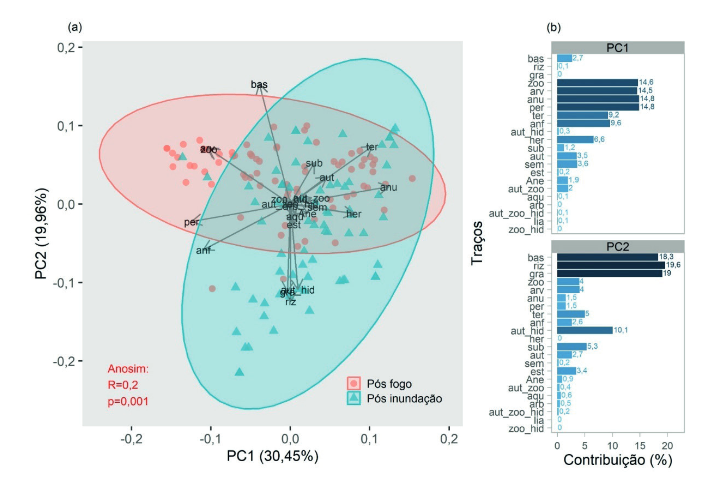Renascimento Verde: uma solução para a restauração de florestas ripárias através do banco de sementes
DOI:
https://doi.org/10.37002/biodiversidadebrasileira.v14i4.2560Palavras-chave:
Áreas úmidas , distúrbios naturais, mudanças climáticas, regeneração naturalResumo
A restauração ecológica é essencial para manter a biodiversidade frente às mudanças globais do clima. O banco de sementes é a principal fonte de manutenção da variabilidade genética de populações e comunidades. Uma avaliação precisa das sementes contidas no solo após um evento extremo sazonal em áreas úmidas traz respostas quanto ao potencial de regeneração natural. Dessa forma, objetivamos investigar o uso dos bancos de sementes do solo como uma ferramenta de avaliação da degradação de florestas ripárias e sua capacidade de regeneração após eventos de fogo e inundações. O banco de sementes foi coletado em dois períodos: pós fogo e pós inundação; e o solo foi avaliado por meio da emergência de plântulas e por contagem direta de sementes. As espécies foram classificadas quanto ao hábito, forma de vida, dispersão, tipo de propagação e ciclo de vida. Registramos como resultados: foi baixo o número de sementes arbóreas e arbustivas; as ervas e gramíneas terrestres e perenes apresentam maiores valores de CWM; e espécies com rebrota basal se destacam das demais. A Cecropia pachystachya é a principal espécie representante dentro do banco de sementes (maior abundância), sendo a zoocoria o principal meio de dispersão, seguido de hidrocoria e autocoria. Pode-se observar que o banco de sementes tem uma diversidade de espécies que não utilizam as sementes como principal meio de regeneração desta floresta ripária. As espécies presentes estão condicionadas a algum tipo de propagação vegetativa e podem se manter no ambiente via rebrote.
Downloads
Referências
Bao F, Pott A, Ferreira FA, Arruda R. Soil seed bank of floodable native and cultivated grassland in the Pantanal wetland: effects of flood gradient, season and species invasion. Braz J Bot. 2014. 37: 239-250. DOI: https://doi.org/10.1007/s40415-014-0076-z
Bao F, Elsey-Quirk T, Assis MA, Pott A. Seed bank of seasonally flooded grassland: experimental simulation of flood and post-flood. Aquatic Ecol. 2017. 1: 1-13. DOI: https://doi.org/10.1007/s10452-017-9647-y
Bao F, Assis MA, Pott A. Applicability of seed bank assessment methods in wetlands: advantages and disadvantages. Oecologia Australis 2021. 25: 22-33. DOI: https://doi.org/10.4257/oeco.2021.2501.03
IPCC. Climate Change 2023: Synthesis Report. Contribution of Working Groups I, II and III to the Sixth Assessment Report of the Intergovernmental Panel on Climate Change [Core Writing Team, H. Lee and J. Romero (eds.)]. IPCC, Geneva, Switzerland, pp. 2023. 35-115. doi: 10.59327/IPCC/AR6-9789291691647 DOI: https://doi.org/10.59327/IPCC/AR6-9789291691647
Middleton BA, Kleinebecker T. The effects of climate-change-induced drought and freshwater wetlands. In Global Change and the Function and Distribution of Wetlands 2012. (pp. 117-147). Dordrecht: Springer Netherlands. DOI: https://doi.org/10.1007/978-94-007-4494-3_4
Junk WJ. Current state of knowledge regarding South America wetlands and their future under global climate change. Aquatic Sci. 2013. 75: 113-131. DOI: https://doi.org/10.1007/s00027-012-0253-8
Lázaro WL, Oliveira-Júnior ES, Silva CJD, Castrillon SKI, Muniz CC. Climate change reflected in one of the largest wetlands in the world: an overview of the Northern Pantanal water regime. Acta Limnol Bras. 2020. 32. DOI: https://doi.org/10.1590/s2179-975x7619
Damasceno-Junior GA, Pott A. General features of the Pantanal wetland. In Flora and Vegetation of the Pantanal Wetland 2022. (pp. 1-10). Cham: Springer International Publishing. DOI: https://doi.org/10.1007/978-3-030-83375-6_1
Walck JL, Hidayati SN, Dixon KW, Thompson KEN, Poschlod P. Climate change and plant regeneration from seed. Glob Change Biol. 2011. 17: 2145-2161. DOI: https://doi.org/10.1111/j.1365-2486.2010.02368.x
Hölzel N, Otte A. Restoration of a speciesâ€rich flood meadow by topsoil removal and diaspore transfer with plant material. Appl Veg Sci. 2023. 6: 131-140. DOI: https://doi.org/10.1111/j.1654-109X.2003.tb00573.x
Jaraâ€Guerrero A, Espinosa CI, Méndez M, De la Cruz M, Escudero A. Dispersal syndrome influences the match between seed rain and soil seed bank of woody species in a Neotropical dry forest. J Veg Sci. 2020. 31: 995-1005. DOI: https://doi.org/10.1111/jvs.12894
Maringer J, Wohlgemuth T, Hacket-Pain A, Ascoli D, Berretti R, Conedera M. Drivers of persistent post-fire recruitment in European beech forests. Sci Total Environ. 2020. 699: 134006. DOI: https://doi.org/10.1016/j.scitotenv.2019.134006
Klupczyńska EA, Pawłowski TA. Regulation of seed dormancy and germination mechanisms in a changing environment. Int J Mol Sci. 2021. 22: 1357. DOI: https://doi.org/10.3390/ijms22031357
Daibes LF, Pausas JG, Bonani N, Nunes J, Silveira FA, Fidelis A. Fire and legume germination in a tropical savanna: ecological and historical factors. Ann Bot. 2019. 123: 1219-1229. DOI: https://doi.org/10.1093/aob/mcz028
Bao F, Elseyâ€Quirk T, Assis MA, Arruda R, Pott A. Seasonal flooding, topography, and organic debris interact to influence the emergence and distribution of seedlings in a tropical grassland. Biotropica. 2019. 50: 616-624. DOI: https://doi.org/10.1111/btp.12550
Damasceno-Junior GA, Semir J, Santos FAM, Leitão-Filho HF. Structure, distribution of species and inundation in a riparian forest of Rio Paraguai, Pantanal, Brazil. Flora. 2005. 200:119-135. https://doi.org/10.1016/j.flora.2004.09.002 DOI: https://doi.org/10.1016/j.flora.2004.09.002
Garcia LC, Szabo JK, de Oliveira Roque F, Pereira ADMM, Nunes da Cunha C, Damasceno-Júnior GA, Morato RG, Tomaz WM, Libonati R, Ribeiro DB. Record-breaking wildfires in the world's largest continuous tropical wetland: Integrative fire management is urgently needed for both biodiversity and humans. J Environ Manag. 2021. 293: 112870. DOI: https://doi.org/10.1016/j.jenvman.2021.112870
INPE - Instituto Nacional de Pesquisas Espaciais. 2024. Monitoramento dos Focos Ativos por Bioma. Acesso em 10 de Dezembro de 2023. Disponível em http://terrabrasilis.dpi.inpe.br/queimadas/situacao-atual/estatisticas/estatisticas_estados/
Oliveira MT, Damasceno-Junior GA, Pott A, Paranhos Filho AC, Suarez YR, Parolin P. Regeneration of riparian forests of the Brazilian Pantanal under flood and fire influence. For Ecol Manag. 2014. 331: 256-263. DOI: https://doi.org/10.1016/j.foreco.2014.08.011
Pettit NE, Naiman RJ. Fire in the riparian zone: characteristics and ecological consequences. Ecosyst. 2007. 10: 673-687. DOI: https://doi.org/10.1007/s10021-007-9048-5
Varpe Ø. Life history adaptations to seasonality. Integrative and comparative biology 2017. 57: 943-960. DOI: https://doi.org/10.1093/icb/icx123
Oliveira PE, Gibbs PE. Pollination and reproductive biology in cerrado plant communities. In: Paulo SO, Robert JM. The cerrados of Brazil: ecology and natural history of a Neotropical savanna. 2002. 5: 329-348. DOI: https://doi.org/10.7312/oliv12042-018
Kohagura TDC, Souza EBD, Bao F, Ferreira FA, Pott A. Flood and fire affect the soil seed bank of riparian forest in the Pantanal wetland. Rodriguésia. 2020. 71: e00052018. DOI: https://doi.org/10.1590/2175-7860202071013
ICMBIO- Instituto Chico Mendes de Conservação da Biodiversidade. Plano de Manejo do Parque Nacional do Pantanal Matogrossense. 2003. 506p.
Soriano BMA. Caracterização climática de Corumbá-MS. 1997.
Hamilton SK, Sippel SJ, Melack JM. Inundation patterns in the Pantanal wetland of South America determined from passive microwave remote sensing. Archiv für Hydrobiol. 1996. 1-23. DOI: https://doi.org/10.1127/archiv-hydrobiol/137/1996/1
Pijl VD. Principles of dispersal in higher plants. 3a ed. 1982. Springer-Verlag, Berlim.
Lozenzi H. Árvores Brasileiras: Manual de identificação e cultivo de plantas arbóreas nativas do Brasil. Instituto Plantarum. 2002. Nova Odessa, São Paulo.
Tabarelli M, Mantovani W. Colonização de clareiras naturais na floresta atlântica no sudeste do Brasil. Rev Bras Bot. 1997. 20: 57-66. DOI: https://doi.org/10.1590/S0100-84041997000100006
Barroso GM, Morrim MP, Peixoto AL, Ichaso CLF. Frutos e Sementes: Morfologia Aplicada à Sistemática de Dicotiledôneas. Viçosa 1999. Universidade Federal de Viçosa.
Pott A, Pott VJ. Plantas do Pantanal. 1994. Embrapa, Brasília.
Pott VJ, Pott A. Plantas Aquáticas do Pantanal. 2000. Embrapa, Brasília.
APG IV. An update of the Angiosperm Phylogeny Group classification for the orders and families of flowering plants: APG IV. Bot J Linn Soc. 2016. 181: 1-20. DOI: https://doi.org/10.1111/boj.12385
R core team. R: A language and environment for statistical computing. R Foundation for Statistical Computing, Vienna, Austria. 2023. Acesso em 20 de Novembro. Disponível em: https://www.r-project.org/about.html
Delignette-Muller ML, Dutang C. fitdistrplus: An R Package for Fitting Distributions. J Stat Softw. 2015. 64: 1-34. https://doi.org/10.18637/jss.v064.i04 DOI: https://doi.org/10.18637/jss.v064.i04
Chao A, Chiu CH, Jost L. Statistical challenges of evaluating diversity patterns across environmental gradients in megaâ€diverse communities. J Veg Sci. 2016. 27: 437-438. DOI: https://doi.org/10.1111/jvs.12420
Hsieh TC, Ma KH, Chao A. iNEXT: an R package for rarefaction and extrapolation of species diversity (Hill numbers). Methods in Ecology and Evolution 2016. 7: 1451-1456. DOI: https://doi.org/10.1111/2041-210X.12613
Laliberté E, Legendre P. A distance-based framework for measuring functional diversity from multiple traits. Ecol. 2010. 91:299-305. DOI: https://doi.org/10.1890/08-2244.1
Ricotta C, Moretti M. CWM and Rao's quadratic diversity: A unified framework for functional ecology. Oecol. 2011. 167: 181-188. DOI: https://doi.org/10.1007/s00442-011-1965-5
Arruda WDS, Oldeland J, Paranhos Filho AC, Pott A, Cunha NL, Ishii IH, Damasceno-Junior GA. Inundation and fire shape the structure of riparian forests in the Pantanal, Brazil. PLoS One. 2016. 11: e0156825. DOI: https://doi.org/10.1371/journal.pone.0156825
Souza EB, Bao F, Damasceno Junior GA, Pott A. Differences between species in seed bank and vegetation helps to hold functional diversity in a floodable Neotropical savanna. J Plant Ecol. 2021. 14: 605-615. DOI: https://doi.org/10.1093/jpe/rtab014
Pott A, Oliveira A, Damasceno-Junior G, Silva JSV. Plant diversity of the Pantanal wetland. Braz J Biol. 2011. 71: 265-273. https://doi.org/10.1590/S1519-69842011000200005 DOI: https://doi.org/10.1590/S1519-69842011000200005
Pott A, Pott VJ. Flora of the Pantanal. In Flora and Vegetation of the Pantanal Wetland (pp. 39-228). 2022. Cham: Springer International Publishing. DOI: https://doi.org/10.1007/978-3-030-83375-6_3
Souza EB, Junior GAD, Pott A. Soil seed bank in Pantanal riparian forest: persistence, abundance, functional diversity and composition. Oecol Aust. 2019. 23: 4-11. DOI: https://doi.org/10.4257/oeco.2019.2304.13
Rösch H, Van Rooyen MW, Theron GK. Predicting competitive interactions between pioneer plant species by using plant traits. J Veg Sci. 1997. 8: 489-494. DOI: https://doi.org/10.2307/3237200
Rounsaville TJ, Baskin CC, Roualdes EA, McCulley RL, Arthur MA. Seed dynamics of the liana Euonymus fortunei (Celastraceae) and implications for invasibility1. J Torrey Bot. 2018. 145: 225-236. DOI: https://doi.org/10.3159/TORREY-D-17-00033
Baskin JM, Baskin CC. Evolutionary considerations of claims for physical dormancy-break by microbial action and abrasion by soil particles. Seed Sci Res. 2000. 10: 409-413. DOI: https://doi.org/10.1017/S0960258500000453
Capon SJ, Brock MA. Flooding, soil seed bank dynamics and vegetation resilience of a hydrologically variable desert floodplain. Freshwater Biol. 2006. 51: 206-223. DOI: https://doi.org/10.1111/j.1365-2427.2005.01484.x
Godefroid S, Rucquoij S, Koedam N. Spatial variability of summer microclimates and plant species response along transects within clearcuts in a beech forest. Plant Ecol. 2006. 185: 107-121. DOI: https://doi.org/10.1007/s11258-005-9088-x
O'donnell J, Fryirs K, Leishman MR. Can the regeneration of vegetation from riparian seed banks support biogeomorphic succession and the geomorphic recovery of degraded river channels? River Res Appl. 2015. 31: 834-846. DOI: https://doi.org/10.1002/rra.2778
Wittmann F, Junk WJ, Piedade MT. The várzea forests in Amazonia: flooding and the highly dynamic geomorphology interact with natural forest succession. Forest Ecol Manage. 2004. 196: 199-212. DOI: https://doi.org/10.1016/j.foreco.2004.02.060

Publicado
Edição
Seção
Licença
Copyright (c) 2024 Os autores mantêm os direitos autorais de seus artigos sem restrições, concedendo ao editor direitos de publicação não exclusivos.

Este trabalho está licenciado sob uma licença Creative Commons Attribution-NonCommercial-NoDerivatives 4.0 International License.
Os artigos estão licenciados sob uma licença Creative Commons Atribuição-NãoComercial-SemDerivações 4.0 Internacional (CC BY-NC-ND 4.0). O acesso é livre e gratuito para download e leitura, ou seja, é permitido copiar e redistribuir o material em qualquer mídia ou formato.











